Developed to improve the checkout experience and inventory management, the barcode revolutionised how we shop, sell, and transport goods. As it turns 50 this month, GS1 Australia reflects on its history and future.
On 26 June 1974, the very first barcode was scanned on a packet of Wrigley’s Juicy Fruit, spurring a vital, global system that would revolutionise how we live, shop and work.
From its earliest known beginnings as lines drawn in the sand on a beach in 1948, the universal barcode came to be 50 years ago when grocery industry leaders agreed on a single universal standard for product identification.
Fast forward to 2024, and barcodes now appear on more than one billion products worldwide and are scanned more than 10 billion times a day. The BBC heralded the barcode as one of the 50 things that made the modern economy.
The barcode’s potential goes beyond just improving efficiency and profitability. It also has a critical role in ensuring product safety and quality. Its ability to provide detailed product information and traceability has led to significant improvements in food safety and recalls.
Australia’s barcode standards body GS1 Australia is celebrating the 50 year “scan-iversary” of the barcode by honouring its beginnings and looking brightly towards the future with the roll out of 2D “Next Generation” barcodes.
Next Generation 2D barcodes have started rolling out across Australia, predominantly in the fresh food departments of major supermarkets. One simple scan at a register and from a smartphone will open up a wealth of product and supply chain information. Consumers will be able to see where their product has come from and how best to recycle its packaging, while retailers can better manage waste and markdowns, inventory and the customer experience.
What started as a way to improve the checkout experience has become an essential tool in the global supply chain. Here’s to another 50 years.





